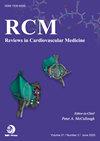下载PDF
{"title":"Predictive Values of the CatLet© Angiographic Scoring System for 30-Day Cardiac Mortality in Patients after Primary Percutaneous Coronary Intervention.","authors":"Chenjie Zhang, Wenhui Liang, Zongliang Yu, Yongming He","doi":"10.31083/RCM28198","DOIUrl":null,"url":null,"abstract":"<p><strong>Background: </strong>The Coronary Artery Tree Description and Lesion Evaluation (CatLet©) angiographic scoring system is a newly developed tool to predict the long-term clinical outcomes for patients with acute myocardial infarction (AMI). This study aimed to evaluate the predictive value of this novel angiographic scoring system for cardiac mortality in AMI patients within 30 days of primary percutaneous coronary intervention (pPCI) in AMI patients.</p><p><strong>Methods: </strong>Patients with AMI undergoing pPCI were consecutively enrolled between January 2012 and July 2013. The CatLet© score was calculated for all the lesions in the non-occlusive status and were tertile partitioned into three groups: CatLet-low ≤14 (N = 124), CatLet-mid 14-22 (N = 82), and CatLet-top ≥22 (N = 102). The primary endpoint was cardiac mortality at 30 days after the procedure. Survival curves were generated using the Kaplan-Meier method, and survival rates among the CatLet© score tertiles were compared using the Log-rank test. Furthermore, Cox regression analysis was performed to identify the associations between the predictors and clinical outcomes.</p><p><strong>Results: </strong>A total of 308 patients were included in the final analysis. The included patients were followed up for 30 days, with 19 (6.17%) cardiac death. Kaplan-Meier curves indicated that the CatLet-top tertile exhibited a significant increase in the risk of cardiac mortality when compared with the low and mid tertiles (<i>p</i> for trend <0.01); the CatLet© score remained an independent predictor of 30-day cardiac mortality in AMI patients after adjusting for clinical variables (HR (95% CI): 6.13 (1.29-29.17); <i>p</i> < 0.01). The multivariable analysis demonstrated that a per 1 unit increase in CatLet© score was associated with a 1.04 (1.01-1.06)-fold increased risk of cardiac death. The area under the receiver operating characteristic (ROC) curve (AUC) statistic for the CatLet© score was 0.80 (95% CI, 0.69-0.91), with a good calibration (χ<sup>2</sup> = 12.92; <i>p</i> = 0.12).</p><p><strong>Conclusion: </strong>The CatLet© score can be used to predict the short-term cardiac death in AMI patients. A CatLet© score ≥22 or ≥11 myocardial segments involved relative to the total 17 segments (the score divided by 2), including culprit or non-culprit vessels, accounting for 65% (11/17) of left ventricle mass involved, is significantly associated with poor prognosis. The current study has extended the application of the CatLet© score in clinical practice.</p><p><strong>Clinical trial registration: </strong>ChiCTR-POC-17013536. Registered 25 November, 2017, https://www.chictr.org.cn/showproj.html?proj=22814.</p>","PeriodicalId":20989,"journal":{"name":"Reviews in cardiovascular medicine","volume":"26 3","pages":"28198"},"PeriodicalIF":1.9000,"publicationDate":"2025-03-17","publicationTypes":"Journal Article","fieldsOfStudy":null,"isOpenAccess":false,"openAccessPdf":"https://www.ncbi.nlm.nih.gov/pmc/articles/PMC11951280/pdf/","citationCount":"0","resultStr":null,"platform":"Semanticscholar","paperid":null,"PeriodicalName":"Reviews in cardiovascular medicine","FirstCategoryId":"3","ListUrlMain":"https://doi.org/10.31083/RCM28198","RegionNum":4,"RegionCategory":"医学","ArticlePicture":[],"TitleCN":null,"AbstractTextCN":null,"PMCID":null,"EPubDate":"2025/3/1 0:00:00","PubModel":"eCollection","JCR":"Q3","JCRName":"CARDIAC & CARDIOVASCULAR SYSTEMS","Score":null,"Total":0}
引用次数: 0
引用
批量引用
Abstract
Background: The Coronary Artery Tree Description and Lesion Evaluation (CatLet©) angiographic scoring system is a newly developed tool to predict the long-term clinical outcomes for patients with acute myocardial infarction (AMI). This study aimed to evaluate the predictive value of this novel angiographic scoring system for cardiac mortality in AMI patients within 30 days of primary percutaneous coronary intervention (pPCI) in AMI patients.
Methods: Patients with AMI undergoing pPCI were consecutively enrolled between January 2012 and July 2013. The CatLet© score was calculated for all the lesions in the non-occlusive status and were tertile partitioned into three groups: CatLet-low ≤14 (N = 124), CatLet-mid 14-22 (N = 82), and CatLet-top ≥22 (N = 102). The primary endpoint was cardiac mortality at 30 days after the procedure. Survival curves were generated using the Kaplan-Meier method, and survival rates among the CatLet© score tertiles were compared using the Log-rank test. Furthermore, Cox regression analysis was performed to identify the associations between the predictors and clinical outcomes.
Results: A total of 308 patients were included in the final analysis. The included patients were followed up for 30 days, with 19 (6.17%) cardiac death. Kaplan-Meier curves indicated that the CatLet-top tertile exhibited a significant increase in the risk of cardiac mortality when compared with the low and mid tertiles (p for trend <0.01); the CatLet© score remained an independent predictor of 30-day cardiac mortality in AMI patients after adjusting for clinical variables (HR (95% CI): 6.13 (1.29-29.17); p < 0.01). The multivariable analysis demonstrated that a per 1 unit increase in CatLet© score was associated with a 1.04 (1.01-1.06)-fold increased risk of cardiac death. The area under the receiver operating characteristic (ROC) curve (AUC) statistic for the CatLet© score was 0.80 (95% CI, 0.69-0.91), with a good calibration (χ2 = 12.92; p = 0.12).
Conclusion: The CatLet© score can be used to predict the short-term cardiac death in AMI patients. A CatLet© score ≥22 or ≥11 myocardial segments involved relative to the total 17 segments (the score divided by 2), including culprit or non-culprit vessels, accounting for 65% (11/17) of left ventricle mass involved, is significantly associated with poor prognosis. The current study has extended the application of the CatLet© score in clinical practice.
Clinical trial registration: ChiCTR-POC-17013536. Registered 25 November, 2017, https://www.chictr.org.cn/showproj.html?proj=22814.

 求助内容:
求助内容: 应助结果提醒方式:
应助结果提醒方式:


